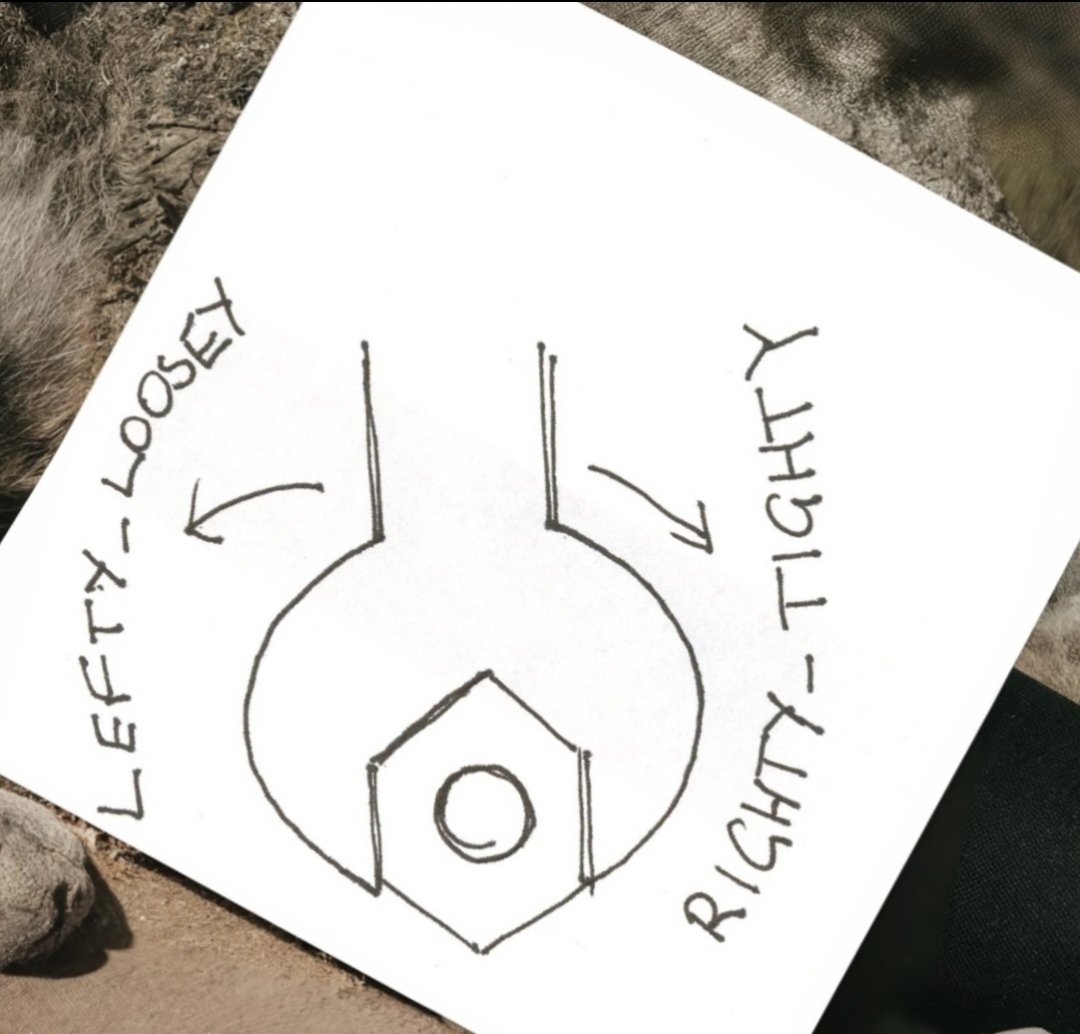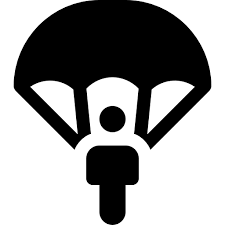The world has a lot of different standards for a lot of things, but I have never heard of a place with the default screw thread direction being opposite.
So does each language have a fun mnemonic?
Photo credit: https://3.bp.blogspot.com/-Giy8OrYJTjw/Tfm9Ne5o5hI/AAAAAAAAAB4/c7uBLwjkl9c/s1600/scan0002.jpg
I like this one more.

I can’t think of an equivalent phrase in Bulgarian for that, but it’s known that [most] threads tighten when turning clockwise… and if you don’t know what direction the clock goes, what are you even doing with screws or bolts…
And again there are special cases even outside of threads - for example in plumbing there are some valves that are open when the handle is parallel to the pipe and closed when the handle is perpendicular - and it might just happen that the closing motion happens counterclockwise.
reverse threads are also found on things like bicycles and cars which have parts that spin counter clockwise
Yep, I’m familiar with those - on almost any bycicle the left pedal would tighten to the crank counterclockwise.
I never really got that one, because “left” vs “right” only works when you are looking at the top of the screw. At the bottom, left tightens, and right loosens. So the one I remember is “clockwise to close”.
Edit: the image on the post is actually a good example. If I’m off the screen to the right holding the spanner, then from my perspective, “left” would tighten.
If you mime tightening a bolt, your thumb moves to the right. And vise versa.
Am i weird if i tighten bolts by moving my fingers up/down intsead of side to side?
Nah I do the same till it’s loose, it’s faster to rotate with minimal rotation. But once it get harder then I do slower but larger rotations with thumb starting from left side and goes towards right for like 120°.
Left or right-handed?
Both. Odd that you would ask without trying it yourself.
With my left hand, my thumb starts facing right, and then sort of goes down and towards the left.
I’ve always thought this too. I understand clockwise/anticlockwise and the direction being defined from the top - but it’s a circle - no matter which way you turn, it spends 50% of the time going either direction. The phrase works with screwdrivers (especially ratcheting ones), but not so much spanners or Hex Keys IMO.
I always railed against this. I’m using clockwise-lockwise from now on.
It works for screws, but as a kid, I was never sure if the clock on the wall should be visualized attached to the ceiling or on the floor when saying “clockwise”. So I was always a bit hessitant on that.
I explained here, but that’s why I prefer using the right-hand-rule. Sometimes thinking about clockwise in strange frame of references hurts my little brain.
Agreed. If the screw moves left or right, it fell out of its hole, lol. I guess “clockwise” is hard to rhyme.
It depends which bicycle pedal you’re screwing in. They have opposite threads, designed where they’re self tightening on each side.
If I remember correctly, old timey glass kerosene lanterns also have backwards threads for some reason
Gas threads and water threads are opposites to each other for safety reasons. Might be part of that thought.
Exactly! Bicycle pedals have a left-hand thread on the left-hand side and “normal” threads on the right-hand side.
Please tell Tongshen, who manufactures the popular TSDZ2 motor. The pedal keeps coming loose because they don’t do this. I keep a key on me to tighten it when it starts to loosen.
Oof, that’s some piss poor engineering right there.
Bottlescrews and turnbuckles both have one end threaded in each direction.
Deleted
deleted by creator
I’ve heard flammable gas uses reverse (left hand) thread to prevent cross connection. At least for welding gases in NZ; not sure about natural gas.
Acetylene does, gas lines are standard pipe.
Suppose it’s cause natural gas runs at like, 1-3 psi, while a fresh tank of acetylene is 5,000?
Least in the US
It’s also torches and everything after the regulator, which run at much lower pressure. At least in NZ
I think it might be because they’re connected and disconnected regularly so misconnection is a common problem, even with colour coding. Gas work on houses involves actually putting the fittings on pipe and is done by people who should be concentrating more on that rather than on what they’re about to weld/cut.
If japanese has one, I’ve never heard it. Japanese wife hasn’t either. She was surprised it’s a thing. She said maybe tradesmen might, but certainly nothing everyone knows
saidaybe?
Probably a typo of “said maybe”
Or a typo of “you’re gonna be the one that saves me”
Though that’s admittedly somewhat less likely.
Though admittedlyafter all
Yes, very likely.
Just another instance where AI said fuck this, I ain’t correcting that today.
My dude, look at my post history. I actually noticed it and though “eh, I’ll fix it later” since my wife had finished her coffee and we wanted to free up a table for the people waiting at the cafe.
Yep. I’m getting worse at typing on my phone as I get older. Or my phone keyboard/screen protector sucks; one of the two
Yugunnabethawunthatsavemeee
Oh no
So when someone changes a light bulb, which direction to turn is just a feeling in their bones?
That’s fair.
Japanese usually just say 時計回り (clockwise) or counter-clockwise
You know this has always confused the fuck out of me. You are going around a circle, how is there left and right? There is up-and-left, down-and-left, either way is left. If I am starting on the right of the circle (assuming I’m looking at it) which way is right? Up or down?
I always think about the direction that the top of the circle turns to apply left or right rotation, though I usually use muscle memory.
Imagine it like a car steering wheel.
You’d say turning the wheel to the right turns the car right.

Think of it like this. Like your hand is holding on the top of the steering wheel.
ok but what is behind this picture? I see fur and old matted flesh? a paw with no nails or an old dogs snout?!?!
It’s better to not ask questions sometimes.
backs away slowly
Use right hand thumb rule. There is no right, there is no left, there is no clockwise or anticlockwise. All of them depend on the way you looks. Rught hand thumb rule fixes it for humans
Clockwise = Righty
Or imagine a bottle cap instead of a screw… Muscle memory kicks in.
Thank you! Clockwise looking down at a bottlecap makes sense!
This has always annoyed me too. I know why it works, but it’s clockwise and counter-(or anti-)clockwise. If you were turning from the bottom, left and right are mixed up. Maybe it’s just too hard to come up with a phrase using those terms?
Clockwise=lockwise
The starting point is on the top.
If it was a wheel, which way would it roll if you turned it like that?
It’s the top part. So if you imagine a little dot at the top (12h) position it would move to the right/clockwise or left/anti-clockwise
Yeah, but once you get one quarter of a rotation through your dot is now moving left.
But the top is still moving right
I don’t think we have a Swedish one. But we call clockwise “medsols” and counterclockwise “motsols”. Meaning “with the sun” or “against the sun” Does everyone have reversed threads on plumbing or is that a Nordic/Swedish thing? All plumbing has the reversed rule, left tightens and right loosens.
In the plumbing sector, left-hand threads are used whenever two pipe ends need to be connected that cannot be rotated. The connector is then equipped with a left-hand and right-hand thread and can therefore easily be screwed between them.
So it’s not just typical for Nordic countries, but depends on the application.
I could give you an example. In my kitchen we have a faucet with a detachable aerator. We detach it when we want to use a attachment for a garden hose. When attaching the aerator or the garden hose attachment, the threads are reversed. I might be wrong, but two opposing threads shouldn’t be able to screw into one another right?
In finnish also same but just replace sun with day. No idea about plumbing though.
Whut. Chaged my bathroom sink not long ago and it definitely loosens to the left/counter clock. Norway.
The reversed rule in plumbing is only for gas lines in the Netherlands.
Let’s start saying “rajtan-tajtan” as some weird anglicism?
Hahaha thats brilliant
Gas pipes. All gas fittings are reversed threaded. So it is virtually impossible to connect one to the other.
Count it outer clockwise
Crank it right in?
Lefty righty, loosie tighty.
i just remember clockwise is tighten lol
I just have it in muscle memory to know which way soda bottle cap tightens
I can easily imagine: “right is right left gets you / it left”
But not every language has the double meanings of right and left.
The odd left-threaded screws are called Linksgewinde in German. Knowing this, you can sort of figure the rest out.
Aren’t left handed threads used when there is torque or rotation that would cause nuts on right handed threads to loosen?
Yes. Bicycle pedals for instance.
The only one I know of is “open counter clockwise”, but after consuming too much media in English I use “righty tighty…”.
I use “Clock-in, counter-out”
One mnemonic is to imagine yourself opening a jar.
Your door is a jar.
Is it a jar of jam or jelly?
I use the right hand rule - ball up your fist with your thumb sticking out, and turning in the direction of your fingers curling will result in the screw going the rest your thumb points.
Right hand for right-handed threads and left hand for left-handed. If unsure, it’s most likely right-handed.
Oh God I hate those sneaky left-thread bastards lol.
The assumption in this whole post is that it’s right-thread, since left is so uncommon.
Most common example would be a bicycle, I think - your pedals tighten on “in the same direction the wheel turns” as you look at them. So your left pedal has left-hand thread, and goes on and comes off backwards.
The effect of precession also means that you can tighten the pedals on finger tight and a good long ride will make them absolutely solid - need to bounce up and down on a spanner to loosen them.
Me learning this about electromagnetism: huh, neat.
Me learning this about something I actually use in day to day life: 🤯
It’s especially helpful when you’re looking at screws (or nuts!) from the back or any other weird frame of reference.
















